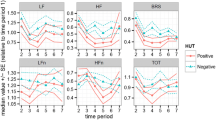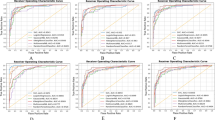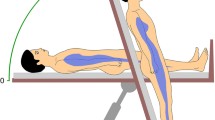Abstract
Reflex syncope is a well-recognized phenomenon, but the understanding of its underlying pathophysiology remains limited. We hypothesized that patients with a history of syncope and a positive head-up tilt test (HUTT) outcome are in a “not-yet defined” abnormal state even before the head-up position. We performed a 45 min HUTT on 86 patients with a history of syncope. We assessed 19 variables during the supine period before head-up position. Of these variables, 9 were cardiovascular variables (CV) while 8 were body composition variables (BC). The two remaining variables were age and sex. Forty-five patients (41 ± 15 years, 22 males) have a positive HUTT outcome and 41 a negative one (46 ± 15 years, 22 males). Statistical tests applied on each of the 19 variables individually did not discriminate patients with a positive and a negative outcome. We used neural networks to screen the sets of variables that allowed for the best predictions of HUTT outcomes. The sensitivity, specificity, positive and negative predictive values (PPV and NPV, respectively) were determined. The best set of predictive values determined from the 19 variables was 76, 81, 78 and 80% for sensitivity, sensibility, PPV, and NPV, respectively. Unexpectedly, the HUTT outcome prediction performed with cardiovascular variables was not better than the prediction performed with body composition variables only. Patients with a positive HUTT outcome are in an abnormal state that can be detected even before the head-up position. Body composition is an important contributor to this abnormal state.
Similar content being viewed by others
References
Bellard E, Fortrat JO, Schang D, Dupuis JM, Victor J, Lefthériotis G (2003) Changes in transthoracic impedance signal predict outcome of 70° head-up tilt test. Clin Sci (Lond) 104:119–126
Bigard AX, Boussif M, Chalabi H, Guezennec CY (1998) Alterations in muscular performance and orthostatic tolerance during Ramadan. Aviat Space Environ Med 69:341–346
Blanc S, Normand S, Pachiaudi C, Fortrat JO, Laville M, Gharib C (2000) Fuel homeostasis during physical inactivity induced by bed rest. J Clin Endocrinol Metab 85:2223–2233
Brignole M, Alboni P, Benditt DG, Bergfeldt L, Blanc JJ, Thomsen PE, Gert van Dijk J, Fitzpatrick A, Hohnloser S, Janousek J, Kapoor W, Kenny RA, Kulakowski P, Moya A, Raviele A, Sutton R, Theodorakis G, Wieling W, Task Force on Syncope, European Society of Cardiology (2001) Guidelines on management (diagnosis and treatment) of syncope. Eur Heart J 22:1256–1306
Colman N, Nahm K, Ganzeboom KS, Shen WK, Reitsma J, Linzer M, Wieling W, Kaufmann H (2004) Epidemiology of reflex syncope. Clin Auton Res 14:I/9–I/17
Colman N, Nahm K, van Dijk JG, Reitsma JB, Wieling W, Kaufmann H (2004) Diagnostic value of history taking in reflex syncope. Clin Auton Res 14:I/37–I/44
Cross SS, Harrison RF, Kennedy RL (1995) Introduction to neural networks. Lancet 346:1075–1079
Fernandez-Alfonso MS (2004) Regulation of vascular tone. The fat connection. Hypertension 44:255–256
Fortney SM, Schneider VS, Greenleaf JE (1996) The physiology of bed rest. In: Fregly MJ, Blatteis CM (eds) Handbook of physiology. Section 4, Vol. II, Environmental Physiology. Oxford University Press, New York, pp 889–942
Hainsworth R (2004) Pathophysiology of syncope. Clin Auton Res14:I/18–I/24
Haller M, Akbulut C, Brechtelsbauer H, Fett W, Briegel J, Finsterer U, Peter K (1993) Determination of plasma volume with indocyanine green in man. Life Sci 53:1597–1604
Haycock GB, Schwartz GJ, Wisotsky DH (1978) Geometric method for measuring body surface area: a height-weight formula validated in infants, children, and adults. J Pediatr 93:62–66
Kaufmann H, Wieling W (2004) Syncope: a clinically guided diagnostic algorithm. Clin Auton Res 14:I87–I/90
Kenny RA, Kapoor WN (2003) Epidemiology and social costs. In: Benditt DG, Blanc JJ, Brignole M, Sutton R (eds) The evaluation and treatment of syncope. Blackwell publishing, New York, pp 23–27
Mallat Z, Vicaut E, Sangare A, Verschueren J, Fontaine G, Frank R (1997) Prediction of head-up tilt test result by analysis of early heart rate variations. Circulation 96:581–584
Natale A, Akhtar M, Jazayeri M, Dhala A, Blanck Z, Deshpande S, Krebs A, Sra JS (1995) Provocation of hypotension during head-up tilt testing in subjects with no history of syncope or presyncope. Circulation 92:54–58
Pavy-Le Traon A, Louisy F, Vasseur-Clausen P, Guell A, Gharib C (1999) Contributory factors to orthostatic intolerance after simulated weightlessness. Clin Physiol 19:360–368
Pitzalis M, Massari F, Guida P, Iacoviello M, Mastropasqua F, Rizzon B, Forleo C, Rizzon P (2002) Shortened head-up tilting test guided by systolic pressure reductions in neurocardiogenic syncope. Circulation 105:146–148
Scherrer U, Sartori C (1997) Insulin as a vascular and sympathoexcitatory hormone: implications for blood pressure regulation, insulin sensitivity, and cardiovascular morbidity. Circulation 96:4104–4113
Acknowledgement
This study was supported by a grant from Centre Evian pour l’Eau. We thank Dr Nisha Charkoudian, PhD for the critical reading of the manuscript and assistance with correct use of English.
Disclosures: The sponsor of the study had no role in the study design, data collection, data analysis, data interpretation or writing of the report.
Author information
Authors and Affiliations
Corresponding author
Rights and permissions
About this article
Cite this article
Fortrat, JO., Schang, D., Bellard, E. et al. Cardiovascular variables do not predict head-up tilt test outcome better than body composition. Clin Auton Res 17, 206–210 (2007). https://doi.org/10.1007/s10286-007-0423-2
Received:
Accepted:
Published:
Issue Date:
DOI: https://doi.org/10.1007/s10286-007-0423-2




